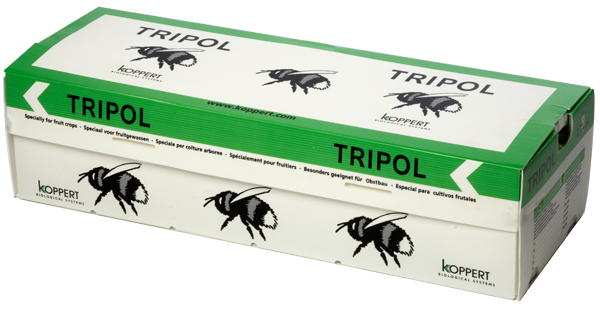Castilla-La Mancha begins pollination with bumblebees to increase production in almond
Koppert Biological System has initiated the introduction of natural pollination with bumblebees in Castilla-La Mancha, to increase production in almond. To this end, it has developed and patented a hive, called commercially TRIPOL, designed specifically to pollinate fruit and woody crops, even with cold and other climatic adversities, and that contributes to increase the almond harvest up to 30%.
Koppert, the world leader in natural pollination and biological control of pests, offers with its hive TRIPOL almond producers in the La Mancha community a natural solution that, in addition to guaranteeing the production of the product, even in adverse weather conditions, is at the same time compatible with auto-fertile varieties.
With TRIPOL, almond farmers have the necessary amount of pollinators at their disposal to ensure the setting of the fruit before the end of the flowering period of the almond trees
Bumblebees are tireless workers who transport more pollen than bees and visit more flowers in less time. In addition, bumblebees are able to work even on cold and cloudy days. The result is a complete pollination in each tree and, consequently, an increase in the almond harvest of up to 30%.
The almond blossom is hermaphrodite and in addition to pollen it also produces nectar. Most of the varieties do not present self-pollination, although in recent years the auto-fertile varieties have been preferred by Castilla-La Mancha producers because they are late blooming to reduce frost risks and offer a higher quality of seed.
Although the new varieties of almond are self-fertile, different studies have shown that the presence of insects, as pollen transporters from one flower to another, is essential in all almond tree plantations
TRIPOL consists of a corrugated plastic box with insulation containing inside it three complete colonies of bumblebees. TRIPOL contains a total of between 350 and 400 bumblebees with a life cycle of around 8 weeks. For pollination of the almond tree, at least two hives per hectare are needed, provided that no other pollinating means is available. The use of bumblebees is perfectly compatible with bees.
A growing crop
The advantages of pollination with almond bumblebees were announced on Tuesday to producers in Albacete during a technical conference organized by Arbolnature, distributor of Koppert, in the Confederation of Employers of Albacete (FEDA). During the day, sponsored by Globalcaja, several researchers confirmed the benefits of the use of bumblebees in pollination of the almond tree and highlighted the possibilities of enhancing the productivity of this crop whose surface does not stop growing in Castilla-La Mancha, but which still has a much lower yield than in the United States, the world’s first almond producer.
In recent years, almond tree plantations have exploded in Spain, which is now the world’s second largest producer
According to Globalcaja, more than half of the plantations of Castilla-La Mancha are in Albacete, but also proliferate in Ciudad Real and Toledo as an alternative to the loss of profitability of the cereal. According to the National Bureau of Dry Fruits, the cultivated area of this product in Castilla-La Mancha in 2016 reached 94,418 hectares declared, ie 20,000 hectares more than in 2015.
Source: KOPPERT
YOU MIGHT ALSO LIKE:
➡️Biological control promotes declining use of pesticides in the last 50 years










